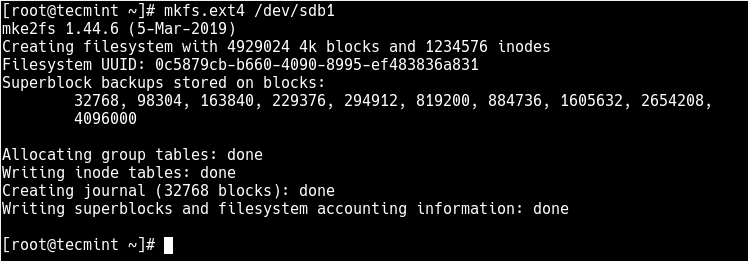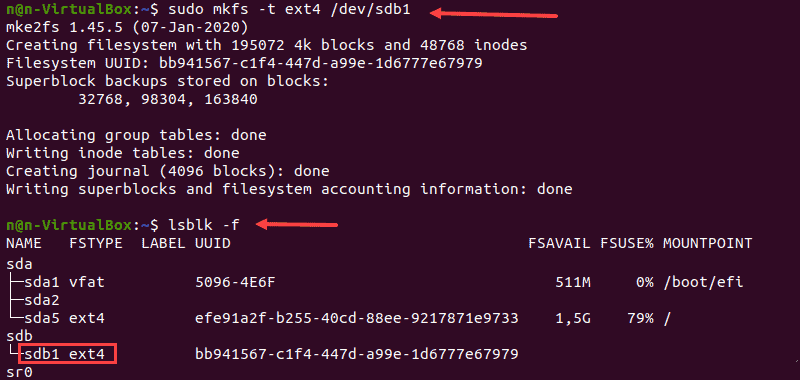
- #LINUX FORMAT PARTITION EXT4 HOW TO#
- #LINUX FORMAT PARTITION EXT4 MAC OS#
- #LINUX FORMAT PARTITION EXT4 UPDATE#
- #LINUX FORMAT PARTITION EXT4 MAC#
- #LINUX FORMAT PARTITION EXT4 WINDOWS#
EDIT: To have a better check for your fs type, run df -T which shows you the correct type of each partition. Then try again to run mkfs.ext4 /dev/sda1. In this example, the disk is /dev/sdc, and its. Your partition number should be 1 (because of /dev/sda1) and you should choose the partition type 83 (Linux). Replace sdc1 with the relevent disk and partition that you want to format. To Format a partition with the ext4 filesystem run the following command: sudo mkfs.ext4 /dev/sdc1. Now your partition has been created, you need to mount it somewhere to use it. The ext4 filesystem is known as the forth extended filesystem, and is the default file system on many Linux distributions. Format the partition with the ext4 file system using the mkfs.ext4 or mke4fs command: Label the partition using the e4label command.
#LINUX FORMAT PARTITION EXT4 UPDATE#
This can take a bit of time, but it should give you an update on what’s being written. It’ll now go off and start writing the filesystem. Write the changes to disk (this can’t be undone). Just hit return for each to accept the defaults. It’ll now ask you to set the start and end cylinders on the disk. If you already have a filesystem on the disk, wipe it. If you formatted an ext4 partition from scratch then it probably uses extents and therefore you cannot mount it as ext3 without re-formatting. Only needed if it’s been mounted already. But others, particularly extents, are ext4-only and once you have used this feature of an ext4 partition there is no going back to being able to mount it as ext3 without re-formatting. If you’re following this, make sure you’re using the correct drive name.
#LINUX FORMAT PARTITION EXT4 WINDOWS#
For example, this command formats the fifth partition on the first disk with the ext4 file system. Windows may not be able to read the filesystem, but it should be able to read the partition table. You can do this with the appropriate mkfs command. If you are connecting your drive for the first time to your Linux system, then you need to create a partition beforehand. Right click on the target partition, then click Format to and select the target filesystem format.
#LINUX FORMAT PARTITION EXT4 HOW TO#
But I end up spending 20 minutes searching every time I need to remind myself how to do it, so I’m putting it here to save me that hassle.įor the code, I’m just going to assume the drive is /dev/sdb. You must format new partitions with a file system before you can use them. The target partition to format is /dev/sda5.
#LINUX FORMAT PARTITION EXT4 MAC#
HFS or the Hierarchical File System was introduced by Apple in 1985 for use in Mac OS.
#LINUX FORMAT PARTITION EXT4 MAC OS#
Neither Windows or Mac OS has a native ext2 ext3 or ext4 support. ext4 has a maximum file size of 16 terabytes and the maximum volume size of 1 exabyte.

Use the following command to perform a file system check.There are plenty of guides for how to do this online. In 2008 the ext4 was introduced which is the most modern dedicated Linux file system. Use the following command to disable journaling for an ext4 file system: #tune4fs -O ^has_journal /dev/sda2


To Format a partition with the ext4 filesystem run the following command: sudo mkfs.ext4 /dev/sdc1 Replace sdc1 with the relevent disk and partition that you want to format. Make sure disk or partition that you want. To conveniently manage Linux Ext4, Ext3, or Ext2 partitions under Windows environment, the freeware-AOMEI Partition Assistant Standard is a great choice. JLinux The ext4 filesystem is known as the forth extended filesystem, and is the default file system on many Linux distributions. List available disks and partitions in your system. STEP 2: Disable journaling for the file system Steps to format disk and partition in Linux: Launch terminal. Use the following command to unmount the partition on /dev/sda2 (let’s say it’s /var): #umount /var STEP 1: Unmount the file system partition journaling you want to disable Here is the steps to disable journaling on ext4 file system (e.g. Sometimes you may be required to disable journaling to improve performance.


 0 kommentar(er)
0 kommentar(er)
